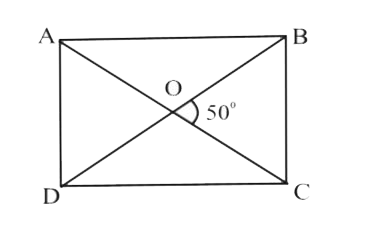The diagonals of a rectangle PQRS intersect at O. if ∠ROQ=60∘ then find ∠OSP.
To solve the problem step by step, we will follow the reasoning laid out in the video transcript.
1. Understand the Given Information:
We have a rectangle PQRS with diagonals PR and QS intersecting at point O. We are given that ∠ROQ = 60°.
2. Identify Vertically Opposite Angles:
Since diagonals of a rectangle bisect each other, we know that ∠QOR is equal to ∠POS because they are vertically opposite angles.
Thus, ∠QOR=∠POS=60°.
3. Recognize the Properties of the Rectangle:
In a rectangle, the diagonals are equal and bisect each other. Therefore, segments OS and OP are equal:
OS=OP.
4. Set Up the Angles in Triangle OSP:
In triangle OSP, we can denote the angles as follows:
- Let ∠OSP = x
- Let ∠SPO = x (since OS = OP, the angles opposite to equal sides are equal)
- We already know ∠SOP = 60°.
5. Apply the Angle Sum Property of Triangle:
According to the angle sum property of triangles, the sum of angles in triangle OSP is 180°:
∠OSP+∠SPO+∠SOP=180°.
Substituting the known values:
x+x+60°=180°.
6. Solve for x:
Simplifying the equation:
2x+60°=180°.
Subtract 60° from both sides:
2x=120°.
Now, divide by 2:
x=60°.
7. Conclusion:
Since x represents ∠OSP, we find that:
∠OSP=60°.
Final Answer:
∠OSP=60°.
We have a rectangle PQRS with diagonals PR and QS intersecting at point O. We are given that ∠ROQ = 60°.
Since diagonals of a rectangle bisect each other, we know that ∠QOR is equal to ∠POS because they are vertically opposite angles.
Thus, ∠QOR=∠POS=60°.
In a rectangle, the diagonals are equal and bisect each other. Therefore, segments OS and OP are equal:
OS=OP.
In triangle OSP, we can denote the angles as follows:
- Let ∠OSP = x
- Let ∠SPO = x (since OS = OP, the angles opposite to equal sides are equal)
- We already know ∠SOP = 60°.
According to the angle sum property of triangles, the sum of angles in triangle OSP is 180°:
∠OSP+∠SPO+∠SOP=180°.
Substituting the known values:
x+x+60°=180°.
Simplifying the equation:
2x+60°=180°.
Subtract 60° from both sides:
2x=120°.
Now, divide by 2:
x=60°.
Since x represents ∠OSP, we find that:
∠OSP=60°.
∠OSP=60°.
Topper's Solved these Questions
- QUADRILATERALS BOOK - MTG IIT JEE FOUNDATIONCHAPTER - QUADRILATERALS EXERCISE - NCERT SECTION (Exercise 8.1 )
20 Videos
- QUADRILATERALS BOOK - MTG IIT JEE FOUNDATIONCHAPTER - QUADRILATERALS EXERCISE - NCERT SECTION (Exercise 8.2 )
11 Videos
- QUADRILATERALS BOOK - MTG IIT JEE FOUNDATIONCHAPTER - QUADRILATERALS EXERCISE - Olympiad/HOTS CORNER
15 Videos
- PROBABILITYBOOK - MTG IIT JEE FOUNDATIONCHAPTER - PROBABILITYEXERCISE - OLYMPIAD/HOTS CORNER
20 Videos
- STATISTICSBOOK - MTG IIT JEE FOUNDATIONCHAPTER - STATISTICSEXERCISE - Olympiad/HOTS Corner
20 Videos
Similar Questions
Knowledge Check
The diagonals of rectangle ABCD intersect each other at O. If ∠BOC=44∘ , then the value of ∠OAD will be
A120∘B68∘C90∘D44∘
The diagonals of a rectangle ABCD intersect in O. if angleBOC=68∘, find angle ODA
View SolutionThe diagonals of a rectangular ABCD intersect at O. If ∠BOC=68∘, then find ∠ODA

View SolutionThe diagonals of a rectangle ABCD intersects at O. If ∠BOC=70∘. find ∠ODA.
View SolutionThe diagonals of a rectangle ABCD intersect in O. If ∠BOC=680, find ∠ODA.
View SolutionThe diagonals of a rectangle are of equal length.
View SolutionIn the following, PQRS is a rhombus, SQ and PR are the diagonals of the rhombus intersecting at O. If angle OPQ=35∘, then find the value of angle ORS + angle OQP.

View SolutionDiagonals of a rectangle are __________.
View Solution

